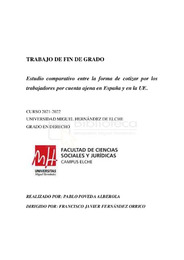Por favor, use este identificador para citar o enlazar este ítem:
https://hdl.handle.net/11000/28358Registro completo de metadatos
| Campo DC | Valor | Lengua/Idioma |
|---|---|---|
| dc.contributor.advisor | Fernández Orrico, Francisco Javier | - |
| dc.contributor.author | Poveda Alberola, Pablo | - |
| dc.contributor.other | Departamentos de la UMH::Ciencia Jurídica | es_ES |
| dc.date.accessioned | 2022-11-15T13:18:29Z | - |
| dc.date.available | 2022-11-15T13:18:29Z | - |
| dc.date.created | 2022-05 | - |
| dc.identifier.uri | https://hdl.handle.net/11000/28358 | - |
| dc.description.abstract | El presente trabajo se centra en un estudio donde se realiza una comparación entre el Régimen General de Trabajadores por cuenta ajena español y el resto de los sistemas asimilados que existen en los países europeos. Durante el desarrollo del mismo se establece una explicación centrada en el sistema de cotización español, relatando la evolución, tanto histórica como legislativa, del sistema español de cotización de la Seguridad Social, centrándose en los trabajadores por cuenta ajena. Como mencionaba anteriormente, se realiza una comparación europea de sistemas, donde se establecen las principales particularidades de cada país, además de destacar qué tipo de sistema se emplea. Por último, se realiza un apartado basado en el coste laboral, y cómo afecta la cotización a la hora de comparar los costes laborales de los diferentes países, y lo que supone que haya diferencias entre las distintas variables que forman parte del mismo. | es_ES |
| dc.description.abstract | The present work focuses on a comparison-study made between the Spanish General Scheme for Employed Workers and the rest of the assimilated systems that exist in European countries. During its development, an explanation focused on the Spanish contribution system is established, recounting the evolution, both historical and legislative, of the Spanish Social Security contribution system, focusing on employed workers. As I mentioned before, a European comparison of systems is carried out, where the main peculiarities of each country are established, in addition to highlighting what type of system is used. Finally, a section based on the labor cost is made, noting how the contribution affects when comparing the labor costs of the different countries, and what it means that there are differences between the different variables that are part of it. | es_ES |
| dc.format | application/pdf | es_ES |
| dc.format.extent | 75 | es_ES |
| dc.language.iso | spa | es_ES |
| dc.publisher | Universidad Miguel Hernández de Elche | es_ES |
| dc.rights | info:eu-repo/semantics/openAccess | es_ES |
| dc.rights | Attribution-NonCommercial-NoDerivatives 4.0 Internacional | * |
| dc.rights.uri | http://creativecommons.org/licenses/by-nc-nd/4.0/ | * |
| dc.subject | Seguridad Social | es_ES |
| dc.subject | cotizar | es_ES |
| dc.subject | cotización | es_ES |
| dc.subject | trabajadores | es_ES |
| dc.subject | empresarios | es_ES |
| dc.subject | Régimen General | es_ES |
| dc.subject.other | CDU::3 - Ciencias sociales::34 - Derecho | es_ES |
| dc.title | Estudio comparativo entre la forma de cotizar por los trabajadores por cuenta ajena en España y en la UE | es_ES |
| dc.type | info:eu-repo/semantics/bachelorThesis | es_ES |

Ver/Abrir:
TFG DERECHO-Poveda Alberola, Pablo.pdf
2,63 MB
Adobe PDF
Compartir:
 La licencia se describe como: Atribución-NonComercial-NoDerivada 4.0 Internacional.
La licencia se describe como: Atribución-NonComercial-NoDerivada 4.0 Internacional.
.png)